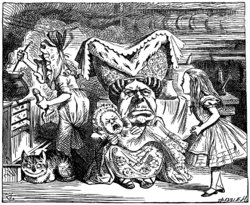Black pepper
Black pepper is a plant that grows in the tropics, especially in India. The plant is a perennial vine that bears flowers. People cultivate the plant for its fruit, the peppercorn. The peppercorn can be used as a spice or condiment. Usually, it makes things hot.
| Black pepper | |
|---|---|

| |
| Pepper plant with immature peppercorns | |
| Scientific classification | |
| Kingdom: | |
| Division: | |
| Class: | |
| Order: | |
| Family: | |
| Genus: | |
| Species: | P. nigrum
|
| Binomial name | |
| Piper nigrum | |
There are several different plants called Pepper, all are in the Piper genus of Piperaceae.
From the 16th century onwards, people used the word pepper to also refer to the Chili peppers, which come from a completely unrelated plant. It was also called black gold in older times.
Culinary uses
Pepper is one of the most common spices used around the world. It is very common in European cuisine, and has been known and traded for a very long time. Very often, the peppercorns are ground, and the powder is used to make things taste hot. They get their heat from a chemical called piperine unlike other peppers that get it from capsaicin.[2]
Medical uses

Like all eastern spices, pepper was historically both a seasoning and a medicine. Long pepper, being stronger, was often the preferred medication, but both were used.
Black peppercorns are mentioned in Ayurveda, Siddha and Unani medicine in India. The 5th century Syriac Book of Medicines prescribes pepper (or perhaps long pepper) for illnesses such as constipation, diarrhea, earache, gangrene, heart disease, hernia, hoarseness, indigestion, insect bites, insomnia, joint pain, liver problems, lung disease, oral abscesses, sunburn, tooth decay, and toothaches.[3] Various sources from the 5th century onward also say pepper is good to treat eye problems. Often special ointments made with pepper have to be applied directly to the eye. There is no current medical evidence that any of these treatments has any benefit; pepper applied directly to the eye would be quite uncomfortable and possibly damaging.[4]
For a long time, people believed pepper is the cause for sneezing; this is still believed true today. Some sources say that piperine irritates the nostrils, which will cause the sneezing;[5] some say that it is just the effect of the fine dust in ground pepper, and some say that pepper is not in fact a very effective sneeze-producer at all. Few if any controlled studies have been carried out to answer the question.
Pepper can irritate the intestines. It is therefore eliminated from the diet of patients having abdominal surgery and ulcers. The replacement is usually called a bland diet.
Pepper contains small amounts of safrole, a carcinogenic compound.
Black Pepper Media
Black, green, white, and pink (Schinus terebinthifolia) peppercorns
A depiction of Calicut, Kerala, India published in 1572 during Portugal's control of the pepper trade
Pepper harvested for the European trade, from a manuscript Livre des merveilles de Marco Polo (The book of the marvels of Marco Polo)
"There's certainly too much pepper in that soup!". Alice said to herself, as well as she could for sneezing — Alice in Wonderland (1865). Chapter VI: Pig and Pepper. Note the cook's pepper mill.
References
- ↑ "Piper nigrum information from NPGS/GRIN". www.ars-grin.gov. Archived from the original on 23 December 2008. Retrieved 2 March 2008.
- ↑ "Black pepper primer - Article". FineCooking. 2008-09-01. Archived from the original on 2021-04-20. Retrieved 2021-04-20.
- ↑ Turner p. 160.
- ↑ Turner p. 171.
- ↑ U.S. Library of Congress Science Reference Services "Everyday Mysteries", Why does pepper make you sneeze?. Retrieved November 12, 2005.
- Turner, Jack (2004). Spice: The History of a Temptation. Vintage Books. ISBN 0-375-70705-0.
Other websites
- Nutritional benefits of Black Pepper Archived 2021-01-26 at the Wayback Machine
- Gernot Katzer's Spice Pages
- Plant Cultures: History and botany of black pepper in South Asia Archived 2006-10-18 at the Wayback Machine
| Wikispecies has information on: Piper Nigrum. |






